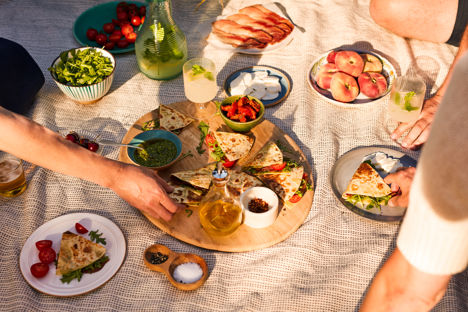
The piadina: Italy’s unsung national dish
Piadine are a type of flatbread hailing from Italy’s Emilia-Romagna region. We find out more about the story behind this much-loved Italian dish
The piadina: Italy’s unsung national dish
Piadine are a type of flatbread hailing from Italy’s Emilia-Romagna region. We find out more about the story behind this much-loved Italian dish
Italy is celebrated worldwide for its wine, cheese, pizza and pasta, but there’s another historic dish that needs to be put firmly on the foodie map: the piadina. Hailing from Italy’s Emilia-Romagna region to the north-east of the country, these unleavened flatbreads – which are typically served folded like sandwiches and stuffed with seasonal ingredients – can be traced back to the ancient Romans. Prevalent in kiosks and restaurants across the region and beyond, the piadina remains an intrinsic part of the cuisine of Emilia-Romagna, and has even been granted IGP status by the EU.
Italian cuisine is celebrated worldwide, with many of its national dishes – from gelato to pizza – firm staples on menus today. But Italy also boasts a great number of lesser-known regional specialities that stand the test of time, and piadina – or Piadina Romagnola I.G.P as it’s traditionally known – is one of them. Hailing from the Romagna part of the Emilia-Romagna region of Italy, which is situated to the north east of the country and boasts the foodie meccas of Bologna and Modena as well as hotspots including Forli, Cesana and Ravenna, piadina (piadine, plural) have been a cherished item of food for centuries.
These unleavened flatbread sandwiches are traditionally made with just a handful of ingredients: flour, water, salt and lard. While the piadina’s simple ingredients have not changed over the years, even as production has stepped up on a mass scale, the ingredients can vary slightly. A number of wheats and grains have been used as piadina bases throughout history, but durum wheat is a popular choice today, as is replacing lard with extra virgin olive oil.
The origins of the piadina can be traced back to the Estruscan period and then the Ancient Romans, where a combination of flours were used to form flatbreads that were then cooked on hot slabs. As piadine could be made cheaply and easily, their popularity continued to soar throughout the Middle Ages, and piadina became an affordable and reliable food source during times of famine and plague. So much so, piadina gained the name ‘pane di poveri’ (‘bread of the poor’) and became associated with ‘cucina povera’ (‘poor cooking’) along with the likes of bruschetta and biscotti. In the early twentieth century, poet Giovanni Pascoli wrote ‘La Piada’, a poem in the flatbread’s honour, which consequently cemented the bread’s name, and catapulted its popularity.
As with the creation of focaccia and pizza, the crafting of piadina comes down to a finely-tuned artisanal process. To make piadine, the flour, water, salt and lard or olive oil is mixed together, then sectioned into small balls. According to tradition, these little balls are then flattened (either by hand or mechanically) before being cooked on high heat on little round, flat pans with a raised edge called testo Romagnolos.
Piadine can also vary depending on whether they’re made according to a traditional ‘Piadina Romagnola’ or a ‘Piadina Romagnola Alla Riminese’ recipe. In the former, the bread tends to have a smaller diameter, and tends to be thicker (think of it as more akin to a flatbread than a wrap).
Regardless of whether you’re tucking into a Piadina Romagnola or a Piadina Romagnola Alla Riminese, there is a key part of the piadine-making process that connects both styles: the folding of the piadine once cooked. Unlike some of the piadina’s flatbread counterparts such as wraps and tortillas, which are typically filled and rolled, piadine are folded to make a flat-bread style sandwich.
Piadine are also best served warm, or even better, fresh off a testo Romagnolo. As well as binding the fillings together, heating these fabulous flatbreads facilitates an essential step in the enjoyment of piadine: the softening and releasing of one of its key ingredients, olive oil, which imparts much of the piadina’s unique and irresistible flavour and characteristically flaky texture.
And it’s the unleashing of the aromas and depth of flavour provided by the olive oil that gives some of Italy’s finest ingredients – which are used to fill piadine – the chance to shine. A popular combination sold at street food kiosks, where the stuffed and folded piadine are neatly tucked into paper wrappers, include Prosciutto Crudo di Parma, Squacquerone cheese, tomato and rocket. Meats such as mortadella, salami and bresaola are also commonly served alongside cheeses such as Scamorza and Mozzarella, salads and sautéed vegetables.
As well as obvious factors such as flavour and quality of ingredients, the piadina’s continued popularity as a street food staple can also be traced back to the post-war economic boom of the 1950s and 1960s, where Italian and European tourists flocked to popular seaside resorts in Emilia-Romagna, such as Rimini and Ravenna. Here, kiosks known as chioschi would line the streets leading to the beaches, serving up freshly-cooked piping hot flatbreads stuffed with seasonal produce.
This seaside nostalgia lives on today, where piadine are still very much a street food found in chioschi (kiosks) and piadinerie (dedicated shops that sell piadine) at Italian seaside destinations and beyond. You’ll also come across piadine in restaurants and in places such as Rimini and Ravenna, it’s not uncommon for piadine to be served in restaurants in lieu of bread, or for piadine to be offered as part of an aperitivo spread.
If you’re unable to get yourself to Emilia-Romagna, you can recreate this delicious Italian street food dish at home thanks to the Crosta & Mollica range of piadine.
Crosta & Mollica piadine are available at Tesco, Sainsbury’s, Booths, Waitrose & Partners and Ocado

